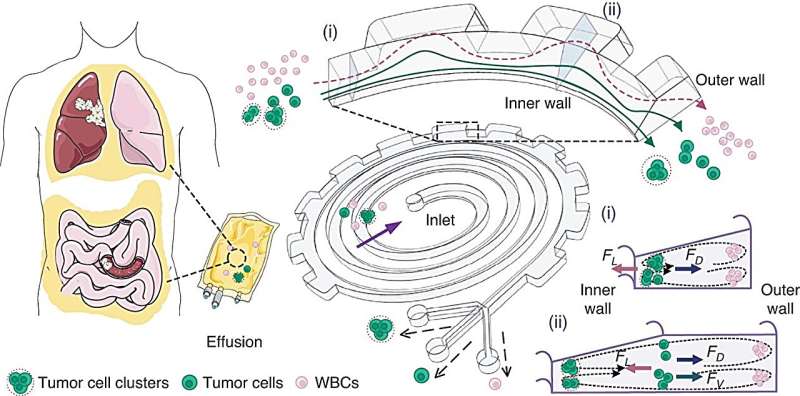This article has been reviewed according to Science X's editorial process and policies. Editors have highlighted the following attributes while ensuring the content's credibility:
fact-checked
peer-reviewed publication
proofread
New microfluidic device for cancer detection achieves precise separation of tumor entities

Understanding the nature of malignant effusions, teeming with tumor cells and clusters, is critical in comprehending the breadth of cancer's impact. The significant role of tumor clusters, with their heightened potential for metastasis compared to individual cells, cannot be overstated in the context of comprehensive cancer care.
While traditional techniques have shown adeptness in isolating single tumor cells, they often fall short when it comes to tumor clusters, thus limiting the scope of clinical research.
The evolution of microfluidic technologies has introduced high-throughput, label-free approaches for the separation of these cells, leveraging their physical characteristics for more precise analyses. However, the challenges presented by tumor cell clusters—primarily their rarity and fragility—call for innovative solutions to ensure their efficient yet careful separation, maintaining their viability for downstream applications.
In response to this challenge, a team of researchers from Southeast University has unveiled a microfluidic device, designed to achieve the precise separation of tumor entities with unprecedented efficiency.
These findings were detailed in an article published in Microsystems & Nanoengineering. This research introduces a device that skillfully integrates slanted spiral channels with periodic contraction-expansion arrays.
This design utilizes inertial forces to adeptly separate single tumor cells, tumor cell clusters, and WBCs from clinical samples of pleural or abdominal effusions—key indicators of cancer metastasis. Operating at a brisk flow rate of 3,500 µL/min, the device not only manages large volumes efficiently but also ensures an exceptionally high degree of separation accuracy.
With over 94% of WBCs effectively removed, the recovery of more than 97% of tumor cells and the preservation of over 90% of vital tumor cell clusters, this technology heralds a new era in cancer diagnostics, facilitating early detection, prognosis evaluation, and the monitoring of treatment outcomes.
Professor Nan Xiang, the study's lead author, said, "Our device represents a substantial advancement in the analysis of malignant effusions. By efficiently isolating tumor cell clusters, known for their considerable metastatic potential, we're forging new pathways for the early detection and treatment of cancer."
This innovation marks a significant milestone in the realm of cancer diagnostics, enhancing the efficiency and throughput of tumor cell and cluster separation from malignant effusions. As such, it sets the stage for more nuanced cancer detection, ongoing monitoring, and the personalization of treatment strategies, heralding a promising future for cancer care.
More information: Zhixian Zhu et al, High-throughput and simultaneous inertial separation of tumor cells and clusters from malignant effusions using spiral-contraction-expansion channels, Microsystems & Nanoengineering (2024). DOI: 10.1038/s41378-024-00661-0




















